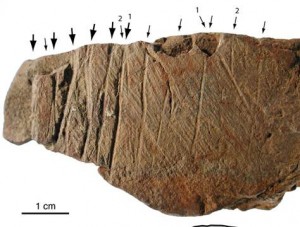Pebble May Be the Oldest H. sapiens Artwork Ever Found
A small pebble made of ochre, discovered in South Africa may be the oldest example ever found of an engraving made by H. sapiens. Researchers from the University of Witwatersrand Institute for Human Evolution (S. Africa) have dated this eight-centimetre-long fragment, part of what was believed to be a much larger object, to around 100,000 years ago, making this object a candidate for the oldest known abstract art.
The colourful pebble was found in the Klasies River Cave (Eastern Cape Province), it is associated with human remains and artefacts from the Middle Stone Age. The Middle Stone Age, the Mesolithic is the period of geological time used by archaeologists to describe the period of human evolution from the ending of the Ice Age phases to the beginning of sedentary farming. It is a “catch all” period with different dates ascribed to Mesolithic artefacts and human remains dependent on where in the world they were found.
Commenting on the research, co-author of the scientific paper, Riaan Rifkin (University of Witwatersrand’s Institute for Human Evolution) stated:
“Associated human remains indicate that the engraved piece was certainly made by Homo sapiens.”
Rifkin and colleagues Francesco d’Errico and Renata Garcia Moreno performed extensive non-invasive analyses of the object. Methods like X-ray fluorescence and microscopic analysis enabled the researchers to examine every minute detail of the ochre pebble. The scientists have concluded that humans or a human deliberately and intentionally made sub-parallel cuts on the pebble – for what purpose remains open to speculation.
The Ochre Pebble – Does is Show Early Human Symbolism?
Picture credit: University of Witwatersrand
Riaan added:
“Upon engraving the piece with a sharp lithic implement [stone tool], it is likely to have produced a markedly bright and dark red-maroon powder. The design may therefore have been strikingly visible shortly after it was produced.”
Ochre- is a naturally tinted clay that mainly consists of hydrated iron oxide. It was amongst the earliest pigments used by humans and other hominids (Neanderthals for example). It is often referred to as the “caveman’s crayon”.
The Klasies River object contains a series of seven deep cuts and several (sixteen or so), smaller and somewhat shallower linear features. It is not known whether the cuts of different magnitude were made by the same person or by different stone tools or made by a second human engraver.
Riaan commented:
“The fragment is a remnant of a formerly semi-circular ochre pebble that likely contained a much more extensive engraved design on its surface.”
The research team are particularly interested in whether or not the engraver or engravers made the design with symbolic intent. Excavations at Blombos Cave, on the southern Cape Coast of South Africa have revealed similar finds of red ochre engraved with geometric patterns. These objects have been dated to approximately 73,000 years ago, but the Klasies River Cave object is much older.
Use of symbols and meaningful images are thought to have been a significant breakthrough in human development. Language, maths and countless other studies are tied to this basic skill, in addition to improved communication. To this day, art permits communication of identity and other things among diverse cultures.
Linear and cross-hatch carved patterns may have been common in Mesolithic culture. As well as the examples found in Blombos Cave, scientists found similar carvings on ostrich eggshell fragments found in the Diepkloof Rock Shelter in the Western Cape Province. Some of these, and other, similar objects may even pre-date the Klasies River pebble, but studies on them are ongoing and research papers yet to be published.
Riaan Rifkin explained:
“The employment of red ochre for symbolic purposes likely played an important role in mediating increasingly complex social relations that emerged during the Middle Stone Age.”
Christopher Henshilwood, a researcher at the University of Witwatersrand, did not work on this study, but he has examined other very early probable engravings. For example, he studied abstract markings of another piece of southern African ochre dating to around 70,000 years ago.
In that case, the engraving consisted of a more complex geometric pattern that looks like the letter “X” repeated in a connected series. Scientists remain puzzled as to what meaning these symbols may have had.
Henshilwood stated:
“They are symbols that I think could have been interpreted by those people as having meaning that would have been understood by others.”
At present, Rifkin and his team are studying 30,000-year old cave art from Africa. So far, they have determined that the abstract images depict a zebra, a rhino and a half human-half cat creature – perhaps a deity symbol or an animal that features in tribal stories. The Klasies River Cave system was inhabited by humans for thousands of years. Excavations have been on-going at this location since the 1960s. The site is one of the most important in the world in terms of H. sapiens evolution and development. The artefacts found have provided an unprecedented insight into early human behaviour, particularly hunting among groups of early humans. Some of the remains and items found in the cave system are believed to date from more than 125,000 years ago.
Visit Everything Dinosaur’s website: Everything Dinosaur.






Leave A Comment